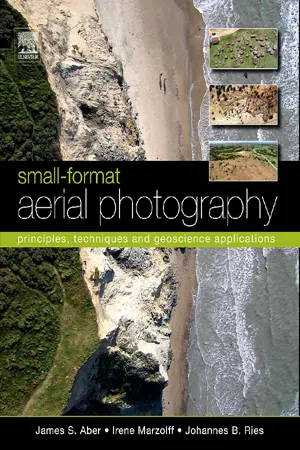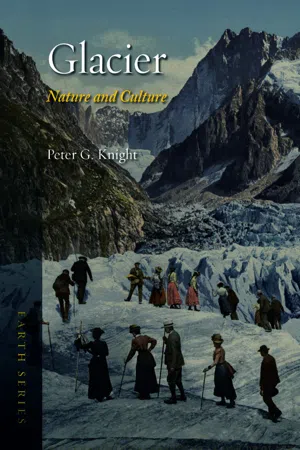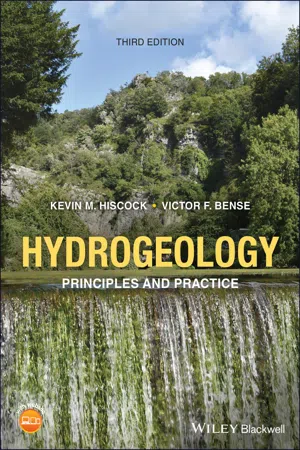Glacial Processes
Glacial processes refer to the various mechanisms through which glaciers shape the Earth's surface. These processes include erosion, transportation, and deposition of sediments, as well as the formation of landforms such as moraines, drumlins, and eskers. Glacial processes are driven by the movement and melting of ice, and they play a significant role in shaping landscapes in polar and high-altitude regions.
5 Key excerpts on "Glacial Processes"
- eBook - ePub
Small-Format Aerial Photography
Principles, Techniques and Geoscience Applications
- James S. Aber, Irene Marzolff, Johannes Ries(Authors)
- 2010(Publication Date)
- Elsevier Science(Publisher)
...Chapter 12 Glacial Geomorphology 12.1. INTRODUCTION Modern glaciers and ice sheets cover approximately 10% of the world’s land area. Of this, most glacier ice is found in Antarctica and Greenland with all other areas accounting for only about 5% of the total. During the Ice Age (Pleistocene Epoch) of the last one million years, glaciers and ice sheets expanded dramatically and repeatedly over large portions of northern Eurasian and North American lowlands and in mountains and high plateaus around the world. At times, the volume of glacier ice during the Pleistocene was at least triple that of today (Hughes et al., 1981). Global sea level declined by at least 120 m, which allowed ice sheets to spread over broad continental shelves, particularly north of Eurasia (Svendsen et al., 1999; Polyak et al., 2000). Geomorphology is the study of the Earth’s surficial landforms both on land and on the seafloor. This study is both descriptive and quantitative; it deals with morphology, processes, and origins of landforms. Glacier ice is a powerful agent that created many distinctive landforms that are well preserved nowadays in regions of former ice expansion. Glaciers modify the landscape in three fundamental ways by erosion, deposition, or deformation (Fig. 12-1). A given site may be subjected to each or all of these processes during the advance and retreat of a glacier, and repeated glaciation may overprint newer landforms on older ones. In addition, glacial meltwater is also an effective geomorphic agent that may erode or deposit conspicuous landforms in connection with glaciation. The results are complex landform assemblages that represent multiple glaciations during the Pleistocene. Aerial photography has long been utilized to illustrate, describe, interpret, and map the diverse types of landforms created by glaciation (e.g. Gravenor et al., 1960)...
- eBook - ePub
- Simon Bell(Author)
- 2012(Publication Date)
- Routledge(Publisher)
...Introduction The previous chapter showed how climate, particularly the aftereffects of the last (but probably not the final) glaciations, has driven and continues to drive many changes occurring in the landscape. The landform patterns and processes which are the subject of this chapter are no exception to this, and in fact in them we can see both the results of climatic processes and their continuing role in modifying climatic processes in the short to medium term, such as volcanic eruptions throwing gas and dust into the atmosphere. The structure and processes of geology supply the basic underlying layer or substrate upon which all terrestrial life and human activities rely. Geology interacts directly with climate to maintain a continuously dynamic state. However, the rates of geological change are generally so slow that for most ecological processes, or considerations for human use, it supplies a relatively stable framework and sets limits or boundary conditions. Areas of ancient shield rocks, where erosion is extremely slow, possess extremely stable geologies. There are places in which dramatic processes occur reasonably frequently, notably in regions with active volcanoes and earthquakes, where processes can disturb and modify ecological or cultural patterns quite dramatically, and occasionally disastrously for anyone living there. It is not the purpose of this chapter to provide a primer on geology, geomorphology or hydrology; instead it is to interpret what we perceive in this field in terms of the patterns and processes, insofar as they help us to read the landscape and to give us a basis for understanding the ecological and human patterns superimposed upon it...
- eBook - ePub
Glacier
Nature and Culture
- Peter G. Knight(Author)
- 2019(Publication Date)
- Reaktion Books(Publisher)
...1 Ways of Thinking about Glaciers A perennial mass of ice, and possibly firn and snow, originating on the land surface by the recrystallization of snow or other forms of solid precipitation and showing evidence of past or present flow. 1 Today, from a distance, I saw you walking away, and without a sound the glittering face of a glacier slid into the sea. 2 Precisely defined for the scientist, a metaphor and an icon for the poet, glaciers for each of us have their own place in our view of the world. Human life has developed in an unusual period of Earth’s history: a period in which there are glaciers. Of the history of the planet, glaciers have been here, on and off, for only about 15 per cent of the time, but they have been here throughout the 2 million years of human history and prehistory. However, only for the last century have we lived in an age in which the importance of glaciers has been acknowledged. It is less than two hundred years since the idea was first widely accepted that ice ages come and go, and that glaciers used to cover much more of the Earth’s surface than they do now. We have only just noticed that we are living in a glacial period. We live now, for the first time, in a cultural ice age as well as a physical one. Few of us consciously place ‘glacier’ at the heart of our view of the world but we do now appreciate the key role of glaciers both in the planet’s past – creating the landscapes that surround us – and in its future, as major players in the unfolding drama of climate change. But at the same time that we noticed glaciers we also realized that the physical ice age may be coming to an end, that we are losing the glaciers, and that it may be our fault that we are losing them so fast. Because we recognize the importance of glaciers in the global system we now have a particular view of the world, different from that of the generations before us...
- eBook - ePub
Applied Climatology
Principles and Practice
- Allen Perry, Dr Russell Thompson, Russell Thompson(Authors)
- 2013(Publication Date)
- Routledge(Publisher)
...Likewise, water resources become critical under extreme climate conditions, especially when supply and demand lose their synchronization under drought episodes. Frozen water bodies (i.e. glaciers) are the true ‘progeny’ of climate which controls all their physical and thermal characteristics. For example, the conversion of snow to glacial ice and the mass balance of glaciers are critically related to climatic conditions (especially atmospheric heat transfers). The influence of climate on geomorphic processes and landforms is not so convincing since, at scales finer than the global or regional, generalizations about the role of climatic inputs in landform evolution have proved more difficult to sustain. The response of a landform to climate is known as landscape sensitivity and lowsensitivity landforms retain their characteristic forms mainly in response to local features and actual morphology, for example the supply of debris to rock glaciers. Over the past century, the above-ground climate has been accepted as one of the main environmental factors involved in soil formation. Soils and climate are indeed intimately interrelated and they bring together two of the most critical environmental parameters of life on the earth. The most important climatic elements are solar radiation, soil temperatures (which control chemical reactions and biological activity) and the soil moisture budget. However, it is evident from present-day soil classifications that there are important deviations in the relationship between soil patterns and climate data, since climate is only one of some five factors responsible for soil formation (Jenny, 1941). Also, soil zonations, based on present-day climate, do not necessarily reflect the conditions under which soils were originally formed, which could have been so different in the past...
- eBook - ePub
Hydrogeology
Principles and Practice
- Kevin M. Hiscock, Victor F. Bense(Authors)
- 2021(Publication Date)
- Wiley-Blackwell(Publisher)
...3 Groundwater and geological processes 3.1 Introduction This chapter discusses the response of groundwater systems to geological processes such as plate tectonics, glaciation and sea‐level fluctuations. Although topography‐driven groundwater flow, as introduced in Chapter 2, is in many areas of the world the dominant mode of groundwater circulation, consideration of the additional impact of geological processes on groundwater flow is often important to fully appreciate the dynamics of groundwater systems on relatively long timescales (millennia). For example, only by considering the hydrogeological impacts of glaciation and associated sea‐level low stand, can the occurrence of fresh water underneath the sea‐floor along much of the continental shelf be understood. In the description of regional groundwater flow systems, which typically reach circulation depths of several kilometres, flow driven by the variable density of groundwater and flow induced by stresses imposed on pore fluids play an important role and often form the sole driver of fluid flow in the absence of topographically driven flow. The variable density of groundwater and anomalous pore pressures can be caused by a suite of geological processes. Thus, to understand fluid flow patterns in relatively deep hydrogeological systems requires an understanding of how the relevant geological processes cause fluid flow. It is the task of the hydrogeologist to evaluate, for a given geological setting, which processes can be expected to be dominant in driving fluid flow in the subsurface. The way groundwater and other geofluids, such as hydrocarbons, respond to geological forcing often has a direct feedback on how geological processes proceed. This feedback mechanism is, for example, important when the influence of fluids on seismicity should be considered...




